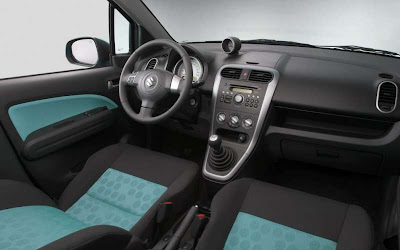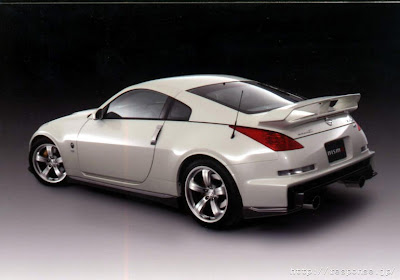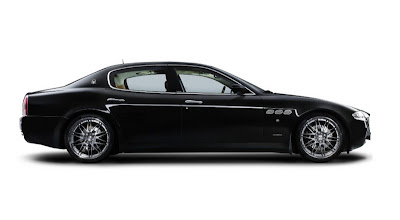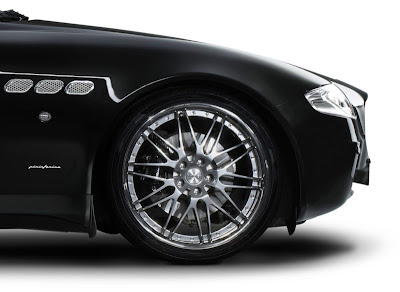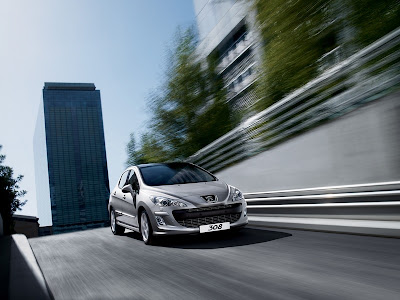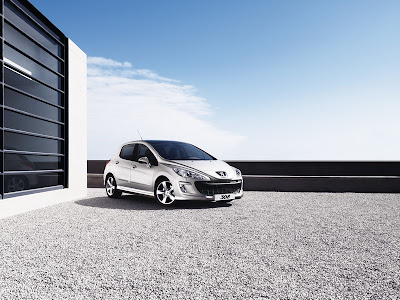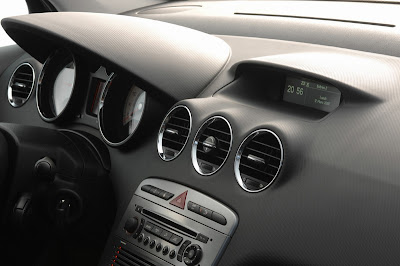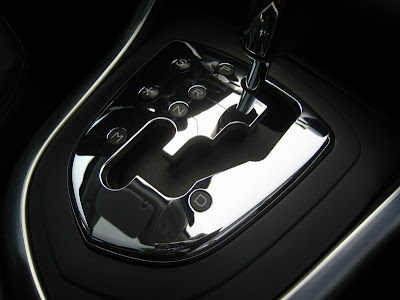

 BIG VALUE FROM FINAL-EDITION IMPREZA WRX
BIG VALUE FROM FINAL-EDITION IMPREZA WRX
Subaru is guaranteeing customers exceptional value from the final-edition versions of its iconic Impreza 2.5 WRX saloon and Sports Wagon.
Called GB270, the last-of-the-line current Impreza offers around £7,600 in extra equipment for the saloon and just under £7,000 for the Sports Wagon.
Both models cost £22,995 on-the-road – only £2,898 and £1,898 more than the standard Impreza WRX saloon and Sports Wagon respectively.
Named after Rally GB – Subaru's most successful WRC stage – and the 270 PS the Prodrive-uprated engine produces, the GB270 models can be ordered from July 10 with first deliveries planned for September 1.
Numbers will be strictly limited to 300 for the Impreza GB270 saloon and 100 for the Sports Wagon.
Standard Prodrive Performance Pack
Both models benefit from the 270 PS Prodrive Performance Pack which boosts power by 40 PS and torque by a staggering 74 lb ft to 310 lb ft.
The result is a 0-60 mph time reduced from 5.9 to 5.3 seconds and a 0-100 mph time of 13.9 instead of 14.4 seconds. Mid-range response is substantially improved.
Other shared features include a lowered spring kit, 'quickshift' gearchange, special carpet mats, MOMO 'Air-Race' gear knob, larger-diameter 18x7.5ins GT1 alloy wheels and GB270 exterior badging and individually numbered interior plaque.Impreza GB270 Saloon
Specific to the Impreza GB270 saloon are a WRC-style rear spoiler, stainless-steel mesh front grille, STI front lip spoiler and silver-finished alloy wheels.Impreza GB270 Sports Wagon
Helping the GB270 Sports Wagon stand out is a rear waist spoiler, front and rear aero splash guards, rear privacy glass, black stainless-steel mesh front grille and gloss-black alloy wheels.
In addition, both models will be available with an optional ICE pack consisting of a Clarion SatNav and iPod adaptor and Bluetooth 'phone kit for £1,750.
Other extra-cost upgrades include a GB270-branded leather or Alcantara/leather interior for £1,400 or £1,600 respectively and privacy glass window tinting for the saloon at £405 (all prices include VAT).
A totally new 5-door Impreza will be launched in the autumn in 1.5 and 2.0 litre naturally-aspirated versions only. The turbocharged STI returns in the spring.
Friday, July 6, 2007
Final Edition Subaru Impreza WRX GB270
Labels: Subaru
Audi AS5 by Abt



 Dynamical Coupe in perfection
Dynamical Coupe in perfection
The new Audi A5 combines a sporty and an unobtrusive design to a powerful, elegant and individual appearance. "A uniquely beautiful car and thus a real challenge for us," says Hans-Jürgen Abt. The managing director of Abt Sportsline raved about the new Coupe from Ingolstadt, but he emphasizes that "our designers and engineers were able to improve the outstanding base model even more". The character of the noble sportscar still maintains but after getting a special treatment in the Allgaeu it appears more dynamical. The body kit, especially tailor-made for the Abt AS5, is a spectacular package: a front skirt with a grid element which emphasizes the singel-frame grill and the fog lights, the slightly curved, laterally mounted body parts and the sleek gill-shaped air-inlets, as well as the well-proportioned rear. With the unobtrusive but striking rear spoiler and the rear skirt inset in diffuser optics, the design of the Abt AS5 is gracefully rounded off. The 4-pipe rear muffler is perfectly fitting and additionally recontoures the rear view. Needless to say that the car sounds as a real Abt car should.
Even when standing still, the Abt AS5 is a sensual car, which eagerly wants to be driven. And when it is allowed to go on the road, it shows how much sports spirit it has. First of all, the 3.0 TDI engine gets a significant "power treatment". The extremely powerful, self-igniting engine perfectly fits to the A5 and, in addition, offers moderate consumption values. By means of improved motor management, Abt turns the serial 240 hp (176 kW) into powerful 272 hp (200 kW). With an extra Abt turbo charger, the power even increases to 300 well feeded horses. Diesel and sportiness belong together since long. Certainly, Abt Sportsline will successively modify later developed A5 engines.
To ensure a perfect handling of the noble power package, Abt also makes use of its adjustable sports suspension, besides the serial Quattro engine. All the more, the Abt AS5 will be brought to a standstill by means of the Abt brake system with a disc diameter of 380 millimeters.
To perfectly round off the successful optics package, Abt Sportsline recommends the AR wheel, which is available for the Audi A5 in the sizes from 18 to 20 inch, of course together with appropriate sport tyres. Wheels, body components and technical modifications build a whole unit: a wonderful Coupe at its best. Not more and not less.
Labels: Audi
2008 Chevrolet Malibu Hybrid
 All-New 2008 Chevrolet Malibu Hybrid Debuts at Major League Baseball's All-Star Game
All-New 2008 Chevrolet Malibu Hybrid Debuts at Major League Baseball's All-Star Game
The all-new 2008 Chevrolet Malibu Hybrid will join baseball's other stars as it makes its world debut in the All-Star Fan Zone today. The Malibu Hybrid's appearance continues through the last out of one of MLB's highlights of the year.
Thanks to an affordable hybrid powertrain option, the all-new 2008 Chevrolet Malibu Hybrid not only will be the most refined new midsize sedan in the neighborhood, but one of the most fuel-efficient, as well. Powered by the GM Hybrid System, the first-ever Malibu Hybrid delivers an EPA rating of 24 mpg city and 32 mpg highway – a two-mpg increase over the non-hybrid four-cylinder model – and will be Chevrolet value-priced, offering customers an affordable hybrid choice.
"The beauty of the Chevy Malibu Hybrid is that customers don't have to choose between a stylish, expressive, fuel-saving sedan full of standard content and the gasoline that goes in the tank," said Chevrolet General Manager Ed Peper. "The Malibu Hybrid's winning package of uncompromising design and fuel economy will help us assert leadership in the midsize sedan segment and meet the needs of Chevy customers."
Production of the Chevrolet Malibu Hybrid is scheduled to begin in October, with vehicles arriving in dealerships shortly thereafter. The system will be available as a powertrain option on the base LS model, which also features Electric Power Steering, Automatic Climate Control and the StabiliTrak electronic stability control system.
The GM Hybrid system featured on the Malibu Hybrid saves fuel by using sophisticated controls and software, as well as a unique, 36-volt electric motor/generator mated to GM Powertrain's 2.4L Ecotec VVT four-cylinder engine and Hydra-Matic 4T45 four-speed transmission. The GM Hybrid system maintains the vehicle's sporty feel and seamlessly reduces fuel consumption by:
* Shutting off the engine when the vehicle is stopped, to minimize idling
* Restarting the engine promptly when the brake pedal is released
* Enabling early fuel shut-off during vehicle deceleration
* Capturing vehicle kinetic energy during deceleration through regenerative braking to charge the advanced nickel metal hydride battery
* Performing intelligent battery charging when it is most efficient
The GM Hybrid system provides additional power, when required, during launch from the electric motor/generator. At wide-open throttle, such as during a passing maneuver, the system enhances acceleration by using the motor/generator to bolster the gasoline engine and achieve maximum power.
The GM Hybrid system also is designed to automatically maintain full accessory functionality – including climate control – when the vehicle is stopped, so that hybrid operation is seamless to the driver and passengers. The Malibu Hybrid delivers an appropriate balance of fuel economy and cabin comfort with an air conditioning system with two selectable modes. The Hybrid A/C mode favors more fuel-efficient performance by limiting the draw on the hybrid powertrain, while the normal mode provides maximum passenger comfort in hot climates and enhances defogging performance.
Malibu Hybrid models make a statement away from the gas pump, too, thanks to specific exterior appointments such as 16-inch low rolling resistance tires and unique hybrid badging. Inside, a special gauge cluster provides information and feedback about the hybrid powertrain's operation.
The 2008 Chevrolet Malibu Hybrid is covered by GM's five-year / 100,000-mile powertrain warranty, the most comprehensive in the industry. In addition, the Malibu Hybrid's advanced nickel metal hydride (NiMH) battery pack is covered by an eight-year / 100,000-mile warranty.
Thursday, July 5, 2007
Ruf Porsche 3400K Edition (25 Jahre Jubilams)


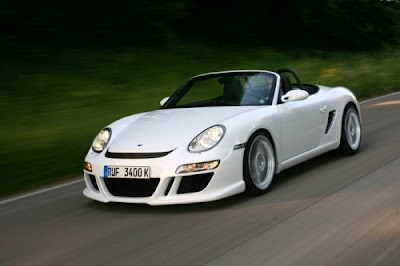

Press Release:
3400 K "25 Jahre Jubiläms-Edition"
With the "25th anniversary edition" model RUF offers an exciting entry vehicle for an attractive price. The 25 years of experience of RUF Automobile GmbH as an authorised automobile manufacturer are the reason for this edition model.
RUF offers the 3400 K in two body versions - as a Coupé (price Euro 79,800 plus VAT) and Roadster (price Euro 75,100 plus VAT).
The agile mid engine concept in combination with a powerful torque and high revving Kompressor engine offers effortless performance and driving pleasure at the highest level.
Power294 kW (400 bhp)at 7,000 rpm
max. Torque440 Nmat 5,500 rpm
Displacement3,387 cm³
Compression ratio10.0 : 1
Performance0-62 mph (0-100 kph) in 4.4 s0-125 mph (0-200 kph)Coupé: in 14.6 sRoadster: in 14.8 s
Top speed181 mph (290 kph)
Wednesday, July 4, 2007
2008 Mercedes-Benz C63 AMG


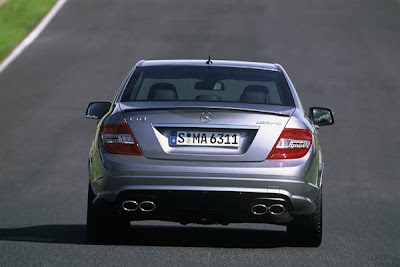



 THE NEW MERCEDES-BENZ C63 AMG
THE NEW MERCEDES-BENZ C63 AMG
A C-Class As Never Before
Note: Release includes European specifications
Affalterbach – In the German Touring Car Championships (DTM) the new AMG C-Class ensures exciting motor racing at the highest level, and now its road-going sister model is celebrating its debut: the new C63 AMG. Its AMG 6.3-litre V8 engine develops a peak output of 451-hp and a maximum torque of 443 lb-ft. – unrivalled figures in this segment. Accordingly the C63 AMG accelerates from zero to 62 mph in 4.5 seconds, while its top speed is electronically limited to 155 mph. In conjunction with an all-new front axle, speed-sensitive AMG sports steering and the new, 3-stage ESPÒ, the AMG sports suspension ensures both outstanding driving enjoyment and exemplary handling dynamics. A combination of expressive design, a decidedly sporty interior and a high level of everyday practicality makes the C63 AMG a unique high-performance car. The C63 AMG will make its U.S. retail debut in spring 2008.
With the new C63 AMG, Mercedes-AMG GmbH is making a confident statement to mark the 40th birthday of the company. The new V8 flagship model is now the fifth generation of the AMG C-Class, whose family tree goes back to the C36 AMG of 1993 – the very first vehicle developed as a cooperative venture between Daimler-Benz and AMG.
Merely the appearance of the C63 AMG is impressive enough, with its wide, road-hugging stance. The new hood with its prominent power domes conceals the independently developed AMG 6.3-litre V8 engine, which develops an impressive 451-hp at 6800 rpm from a displacement of 6208 cubic centimeters. In this respect the C63 AMG comes very close to the 464 or so-horsepower delivered by the AMG C-Class racing touring car in the DTM series. This high output also benefits the power-to-weight ratio, which is a very favorable 3.6 kg/hp.
The maximum torque rating of 443 lb-ft. at 5000 rpm is unrivalled in this class, and the torque curve is equally impressive: from 2000 to 6250 rpm the driver always has more than 369 lb-ft. on tap – ideal for powerful acceleration in any engine speed range.
V8 with thoroughbred racing technology and a designer exhaust note
Introduced in 2005, the V8 engine is installed in numerous AMG high-performance cars and excels with its thoroughbred motor sports technology.
Perfect cylinder charging is guaranteed by the vertical arrangement of the intake and exhaust ducts, as well as the magnesium variable intake manifold with two integral throttle flaps. Other high-tech features include variable camshaft adjustment, four-valve technology with bucket-type tappets, a particularly rigid aluminum crankcase of closed-deck design and the low-friction TWAS coating on the cylinder contact surfaces.
Among the particular strengths of the AMG V8 engine are outstanding responsiveness and enormous pulling power – by virtue of its large displacement, it develops over 30 percent more torque than comparable engines in this performance class. Electronically controlled fuel delivery is another reason for the outstanding agility and responsiveness to movements of the accelerator. With its sporty AMG sound, which was designed-in during a series of sophisticated trials, this eight-cylinder powerpack from Affalterbach offers the unique excitement of a fast-revving, naturally aspirated engine – an audible and immediate experience whether at low, medium or high engine speeds.
Key figures for the C63 AMG at a glance:
C63 AMG
Cylinder arrangement/valves per cylinder: V8/4
Displacement cc: 6208
Bore/stroke mm: 102.2/94.6
Compression ratio: 11.3 : 1
Output hp at rpm: 451 @ 6800
Max. torque Nm at rpm: 443 @ 5000
Acceleration 0-62 mph: 4.5
Top speed mph: 155**Electronically governed
In the interests of optimal reliability, the C63 AMG has a particularly efficient water cooling system and large engine and transmission oil coolers. Located behind the large apertures in the AMG front apron, these coolers ensure non-critical operating temperatures at all times – even under the extreme stress of the racetrack.
Like all AMG high-performance engines, the AMG 6.3-litre V8 is built in the AMG engine shop on the traditional "one man, one engine" principle. This means that one technician is responsible for hand-assembling a complete V8 engine to the highest quality standards – which is attested to by his signature on the AMG engine plate.
AMG SPEEDSHIFT PLUS 7G-TRONIC with blipping function
This high-performance eight-cylinder engine has the perfect partner in the form of the AMG SPEEDSHIFT PLUS 7G-TRONIC transmission. Equipped with AMG steering wheel shift paddles and three driving modes, the seven-speed automatic transmission allows a decidedly sporty or more comfort-oriented style of driving according to the driver's preference. The different modes - "S" (Sport), " C" (Comfort) and "M" (Manual) differ in their shift characteristics and speed: gearshifts in "S" mode are around 30 percent faster than in "C", and no less than around 50 percent faster in "M" mode. Pressing a button is sufficient to activate the desired driving program.
The new C63 AMG is the very first AMG car to feature an automatic throttle-blipping function during downshifts. This not only enhances the driver's emotional experience – the almost completely jolt-free downshifting process also reduces the load-change responses and has a particularly positive effect when braking before bends on the racetrack.
Redesigned Front Axle with 35-millimeter Wider Track
The C63 AMG owes its outstanding handling dynamics to the AMG sports suspension and an all-new three-link front axle design. The stiff configuration of the springs and gas-pressure shock absorbers ensures optimal road contact and low body movements when negotiating serpentine bends at speed. The new front axle has a 35-millimeter wider track – visible by the more widely flared wheel arches – and therefore ensures lower dynamic wheel loads when cornering. A number of features make for substantially more stability and precision in all driving situations: the redesigned wheel location at the front axle is 100 percent more rigid, leading to a considerable improvement in steering precision. Another benefit makes itself felt when braking, as the new wheel location ensures an immediate response even under high dynamic stresses.
In combination with completely newly configured elasto-kinematics, the new wheel location provides greatly improved lateral dynamics and allows the driver of the C63 AMG to benefit from significantly higher cornering speeds. A larger torsion bar stabilizer, new head bearings and dampers with rebound buffer springs further enhance this stability and precision. Steering feedback is also improved by the new kinematics. The speed-sensitive AMG sports steering has a ratio of 13.5:1, but feels more direct as a result of moving what is termed the instant center of motion at the front axle.
The multi-link independent rear suspension has also been thoroughly re-engineered, with a twelve-millimeter wider track and more camber leading to improved cornering performance. Reinforced drive shafts and drive joints increase fatigue strength and round off the improvements to the rear suspension of the C63 AMG.
The completely newly developed AMG sports suspension combines outstanding handling dynamics with the long-distance comfort to be expected of a Mercedes – which also means that the C63 AMG has the characteristic virtues of a genuine AMG.
18-inch AMG light-alloy wheels, 19-inch wheel/tire combination on request
The C63 AMG is appropriately fitted with new, 18-inch AMG light-alloy wheels in a five-spoke design. Painted in titanium grey, these high-sheen wheels in size 8.0 x 18 and 8.5 x 18 are shod with wide-base tires in size 235/40 R 18 (front) and 255/35 R 18 (rear). Even more dynamic handling is made possible by the optionally available 19-inch AMG light-alloy wheels in a multi-spoke design. The front wheels are in size 8.0 x 19 with 235/35 tires, with 9.0 x 19 wheels and 255/30 R 19 tires at the rear.
Generously dimensioned AMG high-performance braking system
Internally ventilated and perforated disc brakes all-round reside behind the spokes of the AMG wheels. The front brakes have size 360 x 36-millimeter discs with six-piston fixed calipers, while deceleration at the rear is by 330 x 26-millimeter discs with four-piston fixed calipers. The AMG high-performance braking system is characterized by great sensitivity and high fade-resistance.
3-stage ESPÒ with Sport function as a new feature in the C63 AMG
The Electronic Stability Program ESPÒ is specifically configured for the dynamic performance of the C63 AMG, which is the first AMG model to feature the 3-stage ESPÒ with a Sport function. This system offers three different control settings, and is a logical further development of the AMG ESPÒ philosophy. The ESP key in the center console enables the driver to choose between three modes - "ESP ON",
"ESP SPORT" and "ESP OFF" – the currently active mode is shown in the central display of the AMG instrument cluster.
In "ESP ON" mode, the onset of handling instability leads to braking intervention at one or more of the wheels, accompanied by a reduction in engine torque. Briefly pressing the ESP key activates "ESP SPORT". In this mode the braking intervention to counter oversteer or understeer, as well as the accompanying reduction in engine torque, allows a higher dynamic threshold and, for instance, corresponding drift angles – which means that the driver of the C63 AMG benefits from considerably more active driving pleasure. ESPÒ is restored to its normal function as soon as the brake pedal is operated.
Prolonged pressure on the ESP key activates "ESP OFF". There is no intervention to control the handling dynamics, and no reduction in engine torque – thus increasing driving enjoyment even further. "ESP OFF" should only be used by experienced drivers on dedicated racetracks. In this mode too, operating the brake pedal restores all the normal functions of ESPÒ.
The system's traction logic is active in all three ESPÒ modes. If one of the drive wheels threatens to spin, specific brake pressure is applied to create the effect of a mechanical differential lock. This means that the engine power is optimally transferred to the road.
More distinctive exterior design than ever before
It is not only in technological but also in visual terms that the new C63 AMG is more distinctively different from the standard C-Class than ever before. The front end is dominated by the new bonnet with its two pronounced power domes, as well as the trademark AMG radiator grille with a central star and two louvers with chrome inserts. The honeycomb pattern of the grille is also reflected in the large air dams of the new, athletically contoured front apron which forms part of the AMG-specific bodystyling. The fog lamps with chrome surrounds are spaced well apart, acting together with the flared front wheel arches to accentuate the width of the car – with the striking transition from the front apron to the wings leaving a particularly strong impression. The side air vents in the front apron serve to expel the hot air from the oil coolers. If the C63 AMG is specified with the optional bi-xenon headlamps or the Intelligent Light System, the headlamps are also dark-tinted.
Eye-catching features when viewed from the side include the 18-inch AMG light-alloy wheels, the harmoniously integrated "6.3 AMG" lettering on the front wing and the AMG side skirts. At the rear the standard LED rear lights, the AMG rear apron with its black diffuser insert and three pronounced diffuser fins, as well as the AMG sports exhaust system with two chrome twin tailpipes, provide further visual highlights that are hallmarks of the brand. The AMG spoiler lip on the boot lid reduces lift and ensures greater handling stability at high speeds.
AMG interior with new sports seats and performance steering wheel
This decidedly sporty theme is continued in the interior of the C63 AMG, which now has special AMG sports seats with integral head restraints for the first time. The seats not only feature a new design with cross-piping and AMG lettering, but also an adaptive backrest with adjustments for the side bolsters and lumbar support. Perfect handling control is assured with the new AMG performance steering wheel in a three-spoke design, which has a rim diameter of 365 millimeters and a flattened lower section. The upper section is covered in perforated leather, and two silver AMG shift paddles enable the gears to be shifted manually.
AMG main menu with a wide variety of displays
The trademark AMG instrument cluster in a tubular design features newly styled dials, AMG-specific lettering and a new night-time design. Eye-catching details include the 320 km/h speedometer scale, AMG lettering, red needles and the "6.3 V8" logo in the rev counter. The AMG main menu in the central display allows numerous settings, with "Warm Up", "Set Up" and "RACE" modes activated via buttons on the AMG performance steering wheel. "Warm Up" displays the engine oil and coolant temperature, "Set Up" the current ESPÒ mode and the transmission mode "S", "C" or "M". "RACE" mode makes the RACETIMER available, with which the driver is able to measure lap times on a racetrack.
Development and design of the C63 AMG
Creating a new car is a complex undertaking, and this certainly applies to the new Mercedes-Benz C63 AMG whose conceptual phase commenced in 2004. This began with the fundamental feasibility study known as packaging. The new C63 AMG was first constructed as a digital model, the engine, cooling system, fuel system, drive train and axles being "married" with the bodyshell to examine buildability. In spring 2005 the first 1:4-scale design models were produced on the basis of drawings and computer images, and in addition the first testing & development vehicles were already built on the basis of the preceding C 55 AMG. This made it possible to test major assemblies such as the drive train, brakes and axles.
The latest onboard measuring technology provided valuable data such as engine oil, coolant and brake disc temperatures – but other aspects of interest were lap times e.g. on the north loop of the Nürburgring, as well as measurable, precisely defined handling maneuvers to provide comparisons between different axle configurations. These tests were accompanied by extensive aerodynamic tests on the bodyshell of the C63 AMG, and it was only then that the final design was approved.
Following approval of the concept in the autumn of 2005, the first fully-fledged prototypes of the C63 AMG were built. At the same time the high-performance saloon was also produced as a digital prototype. Computer simulations made it possible for the "real" development prototypes to exhibit a very high level of maturity during the first rollout. These simulations included the most important vehicle functions, such as handling dynamics, the engine and drive train, bodyshell durability, suspension performance, passive safety, the engine's thermal characteristics and performance/fuel consumption.
From Affalterbach to every climatic zone on earth
The standardized and highly sophisticated AMG development and test program for the C63 AMG began in summer 2005. Over the next couple of years around 20 vehicles were dispatched all over the world from Mercedes-AMG GmbH in Affalterbach, to be subjected to strenuous tests in every climatic zone.
Test, analyze and optimize – that is the creed of the specialists at AMG to achieve the objectives laid down in the book of specifications. Another decisive aspect was an ongoing dialogue between Design and Development, so that any necessary technical modifications were also implemented in design terms.
The major test stages at a glance:
Development testing of the engine, transmission and drive train
· Altitude tests in Denver, Colorado (USA), Lesotho (South Africa), Mont Ventoux (France) and Granada (Spain)
· High temperature tests in Death Valley, California (USA), Upington (South Africa), Idiada proving ground (Spain) and Phoenix, Arizona (USA)
· Driving trials in Los Angeles, California (USA)
· Cold temperature tests in Arctic Falls (Sweden)
Development testing of the cooling and fuel systems
· Various driving trials on the high-speed tracks in Nardo (Italy) and Papenburg
· Trials in Upington (South Africa) and Death Valley, California (USA)
· Tests in the DaimlerChrysler wind tunnel
Development testing of the braking and control systems
· Brake testing on the high-speed track in Nardo (Italy) and the Grossglockner Alpine pass (Austria)
· Testing of dynamic control systems on the Idiada proving ground (Spain), in Arjeplog (Sweden) and on the Boxberg proving ground
In addition various endurance trials are run, with the aim of simulating the vehicle's entire lifecycle under the most severe conditions:
· North loop of the Nürburgring: The car's drive train, suspension, wheel location system, dynamic control systems, tires and brakes are tested on the world's most demanding racetrack.
· Long-term testing on different roads: All the components and systems are tested together in everyday operation. Loaded up to their permitted gross vehicle weight, the test cars are put through a precisely defined test program on country roads, motorways and in city traffic.
· Endurance testing on the DaimlerChrysler proving ground in Papenburg: Extreme acceleration and braking manoeuvres with a high proportion of full load operation, making extreme demands on the cooling and fuel delivery systems.
· Endurance testing in the Swabian Alb region: The vehicles are loaded up to their permitted gross vehicle weight and driven on country roads with numerous uphill and downhill gradients, placing extreme loads on the transmission and drive train.
· "Heide" endurance testing: (named after the poor post-war roads across the "Lüneburger Heide"): 2000 kilometers of extreme trials on the test track or on state-of-the-art test rigs. In this case the focus of the developers is on the durability of the drive train components, the entire bodyshell and the integral subframe on which the front axle, steering and engine are mounted. The test cars are loaded up to their permitted gross vehicle weight.
These tests are supplemented with extensive crash simulations and real crash tests, to provide the necessary evidence for country-specific certifications without which no registration would be possible. The end result is final vehicle approval – the green light for the launch of the C63 AMG.
Mercedes-Benz C63 AMG
Engine
No. of cylinders/arrangement: 8/V, 4 valves per cylinder
Displacement cc: 6208
Bore x stroke mm: 102.2 x 94.6
Rated output hp: 451 at 6800 rpm
Rated torque Nm: 443 at 5000 rpm
Compression ratio: 11.3 : 1
AMG SPEEDSHIFT PLUS 7G-TRONIC7-speed automatic
Ratios
Final drive: 2.85
1st gear: 4.38
2nd gear: 2.86
3rd gear: 1.92
4th gear: 1.37
5th gear: 1.00
6th gear: 0.82
7th gear: 0.73
Reverse: -3.42/-2.23
Running gear
Front axle: Three-link suspension, anti-dive, coil springs, gas-pressure shock absorbers, stabilizer
Rear axle: Multi-link independent suspension, anti-squat and anti-lift, coil springs, gas-pressure shock absorbers, stabilizer
Braking system
Disc brakes all round, internally ventilated and blind-drilled, foot-operated parking brake at rear, ABS, Brake Assist, 3-stage ESP®
Steering
Speed-sensitive rack-and-pinion steering, steering damper
Wheels
Front: 8.0 J x 18; rear: 9.0 J x 18
Tires
Front: 235/40 ZR 18; rear: 255/35 ZR 18
Dimensions and weights
Wheelbase mm: 2765
Track width front/rear mm: 1568/1525
Overall length mm: 4725
Overall width mm: 1795
Overall height mm: 1438
Turning circle m: 10.8
Boot capacity*: 475
Kerb weight acc. to EC kg: 1730
Payload kg: 505
Perm. gross vehicle weight kg: 2200
Tank capacity/reserve l: 66/8
All figures are provisional; * Acc. to VDA measuring method; ** Electronically governed
Labels: Mercedes-Benz
Suzuki Splash: More Details
Suzuki Motor Corporation, the world leader in the compact car segment, introduces Splash, an all-new compact model aimed at building on the success of the loveable Swift. Following Swift, Grand Vitara and SX4, Splash is the fourth all new Suzuki model within just three years, and it epitomises Suzuki’s ‘Way of Life!’ philosophy, underpinning its strategy of building cars that excite customers all over the world.
Splash for Europe will be built in Esztergom, Hungary, by Magyar Suzuki Corporation, a Suzuki subsidiary that already builds Swift, SX4 and Ignis. Suzuki will also be manufacturing the second generation Agila for Opel/Vauxhall at this plant. With identical engineering, the main visual differences between Splash and Agila include different styling at front (bonnet, wings, headlamps and bumper) and rear (tailgate, tail lights and bumper).
Suzuki is targeting annual sales of approximately 60,000 units throughout Europe. Opened in 1992, the Esztergom factory has produced over one million Suzukis to date.
Splash cannot be considered to be the successor of the Wagon R+, the enlarged version of the Wagon R which in 1993 was originally developed for the Japanese market, and later also introduced in Europe. “Based on completely different criteria, Splash’s design is mainly tailored to the requirements of European customers,” explains Toshihiro Suzuki, the project’s Chief Engineer. Splash comes with attractive styling, compact dimensions, responsive handling, very good build quality and a high degree of environmental compatibility.
While the focus of Phase One of Suzuki’s “World-Strategy” was on sportiness, Splash is the first model in Phase Two which will focus on young families as its main target group. Apart from fresh and sporty styling, young couples with and without children attach great importance to attributes such as spaciousness, flexibility and economy.
Rather than a purely functional box shape, the designers have endeavoured to provide Splash with styling that lives up to its name, epitomising youthfulness, freshness and zesty, energetic performance.
Styling and the design philosophy
The styling team for Splash was headed by Akira Kamio (44), who also played a big part in the styling of Swift. As early as 2003, he began to analyse the necessary characteristics for a future European mini-MPV.
It soon became clear that whilst it should not look like a shrunken version of a full-sized MPV this car must keep all of its advantages: the high seating position and resulting good all-round visibility, the pleasant feeling of space and great flexibility allowing the rear compartment to be easily turned into a substantial stowage space.
In order to get up-to-date information, a group of 10 Suzuki designers from Japan travelled to Germany in January, 2004 to spend a period of six months there. They analysed European trends in cars, fashion, lifestyle and design.
Out of their impressions and findings, they finally distilled three models, which, in so called ‘car clinics’, were then presented to audiences of owners of compact cars and small MPVs. In the end, these audiences favoured the model offering the optimum combination of dynamic sportiness with youthful styling, implying a positive attitude to life and maximum suitability for everyday and recreational use.
At the Paris Motor Show in late September 2006, Suzuki presented ‘Project Splash’, a concept car showcasing a taste of the styling of the future production-version Splash. The extremely positive response of the audience confirmed to Akira Kamio and his team that they had taken the right path for Splash. One thing is certain: Splash will be a major player in the mini-MPV segment. While ideally suited to tight parking conditions, the 3.72 m-long car nevertheless offers sufficient space for up to five occupants plus plenty of sports and leisure equipment.
Apart from attractive styling, a cute minicar also requires the best engineering. This includes safe and precise handling, outstanding ride comfort, a high degree of environmental compatibility, and optimum passive and active safety. Hence Splash uses a 30 mm shorter wheelbase version of the Swift’s platform, Suzuki’s current best seller.
The chassis, steering and brakes were adapted to the new parameters in extensive tests, which included tens of thousands of miles of testing over various types of European roads, from English cobblestones, through twisty southern Spanish tracks to fast German autobahns.
Choice of three engines
Splash will make its debut at the Frankfurt International Motor Show in September, with sales commencing in Spring, 2008. Customers will have the choice of three engines – two petrol and a diesel. The petrol units are 100% Suzuki designs, a 1.0-litre 3-cylinder unit producing 65 PS (48 kW) and a 1.2-litre 4-cylinder engine developing 86 PS (63 kW). Both are of advanced four-valve-per-cylinder design, offering a sophisticated combination of smoothness, low-end torque and fuel efficiency.
Diesel fans can choose the 1.3-litre common-rail direct injection engine available with a DPF (Diesel Particulate Filter). Producing 75 PS (55 kW), this 4-cylinder unit is manufactured by Suzuki at its new diesel engine plant in India under licence from Fiat Group Automobiles.
All three engines are combined with a 5-speed manual gearbox. The 86 PS petrol version can also be ordered with a 4-speed automatic transmission. Given the stricter standards now being demanded with respect to environmental compatibility, all engines are Euro4-compliant, with CO2 emissions between 120 and 140 g/km in combination with manual transmissions.
Safety
Suzuki has paid great attention to safety measures in the design of Splash. Active safety features include ABS, brake assist, electronic brake-force distribution and ESP®. Passive safety features include six airbags (dual front side and curtain airbags), a crash-optimised, rigid passenger cell, plus seatbelt-force limiters and seatbelt pretensioners for the front seats. For enhanced pedestrian protection the front end of Splash is fitted with energy-absorbing structures.
Notes: ESP® is a registered trademark of DaimlerChrysler.The data in this release is provisional and subject to change.
Source: Suzuki
Labels: Frankfurt Motor Show, Suzuki
Lexus LS 600h prices
 The LS 600h, the new hybrid power flagship of the Lexus brand, will cost from £81,400 when the model goes on sale in the UK on 1 October. Equipped with a more advanced powertrain and more sophisticated array of preventive, active and passive features than any car in its class, the LS 600h will set new standards in luxury motoring. A superb specification will ensure owners enjoy supreme comfort, convenience and on-board entertainment.
The LS 600h, the new hybrid power flagship of the Lexus brand, will cost from £81,400 when the model goes on sale in the UK on 1 October. Equipped with a more advanced powertrain and more sophisticated array of preventive, active and passive features than any car in its class, the LS 600h will set new standards in luxury motoring. A superb specification will ensure owners enjoy supreme comfort, convenience and on-board entertainment.
The Lexus LS 600h features the world’s first full-time, all-wheel drive full hybrid V8 powertrain, combining a technically peerless 5.0-litre engine with a powerful, high-output motor. The result is performance that rivals a standard V12 petrol engine (nought to 62mph in 6.3 seconds) with fuel consumption and emissions that are on a par with the segment’s best performing – and substantially lower powered – diesels (30.4mpg and 219g/km in combined cycle driving). Thanks to the Lexus Hybrid Drive system’s compact but powerful electric motor, maximum torque is delivered from zero rpm, giving the car exceptional performance off the line.
Two versions will be available in the UK: the Lexus LS 600h and LS 600h L long wheelbase model. Both benefit from an exceptional specification that includes pre-crash safety systems that can detect collision hazards both on the road ahead and from the rear, permanent four-wheel drive, Adaptive Variable Suspension and the world’s first application of LED technology for low beam headlight illumination. Advanced technologies are dovetailed with the skills of master craftsmen to achieve a high luxury finish in the paintwork, fine leather upholstery, hand-trimmed dashboard and real wood cabin trim features.
The in-car entertainment package includes a 19-speaker Mark Levinson premium hi-fi with six-disc DVD autochanger and a nine-inch ceiling-mounted screen for rear seat passengers.
The Lexus LS 600h L can be additionally specified with a Rear Seat Relaxation Pack that provides even higher levels of comfort. The left hand rear seat gains an extending ottoman leg and thigh rest, seat cushion airbag and variable massage function. An independent DVD system, centre console with extending wood-inlaid tray are also part of the pack, together with a more advanced climate control system that uses body temperature sensors to determine optimum performance.
Lexus LS 600h prices
MODEL OTR PRICE
LS 600h £81,400
LS 600h L £83,645
LS 600h L with Rear Seat Relaxation Package £88,000
Labels: Lexus
Tuesday, July 3, 2007
Monday, July 2, 2007
TechArt GTstreet Based on Porsche 911 Turbo


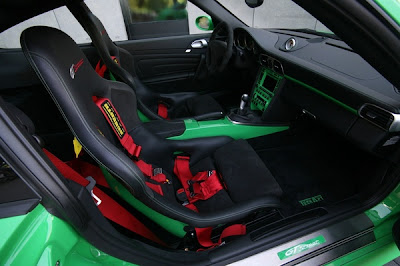

 TechArt GTstreet Based on Porsche 911 Turbo
TechArt GTstreet Based on Porsche 911 Turbo
With its 2001 TechArt GTstreet based on the Porsche 911 Turbo of the 996 model series, TechArt Automobildesign created one of the fastest and most powerful street-legal sports cars of its time. The next evolutionary stage of this fascinating concept celebrates is now available: The new TechArt GTstreet, based on the 911 Turbo of the latest 997 series, starts at 245,000 Euros MSRP.
Like the predecessor the new GTstreet edition centers on a powerful engine: The 3.6-liter twin-turbo flat engine is modified by the TechArt engine specialists and now develops 630 hp / 463 kW at 6,800 rpm, up from standard 480 hp / 353 kW. Peak torque increases from 620 Nm to 820 Nm at 4,500 rpm.
The TechArt TA 097/T3 engine conversion comprises two special VTG turbochargers, a new air box with sport air filter, high-performance manifolds, intercoolers and a stainless-steel sport exhaust system with high-performance catalysts. The precise optimal interaction of all modifications is ensured by a newly programmed engine management system.
Power is transferred to all four wheels via a modified transmission with TechArt gear-throw shortening.
Thus equipped the TechArt GTstreet delivers performance that firmly places it among the world's fastest sports cars: 0 - 100 km/h in just 3.2 seconds, 200 km/h after just 10.9 seconds and a top speed of 345 km/h speak volumes.
The body kit for the TechArt GTstreet was created in the wind tunnel, and offers an optimal symbiosis of aerodynamic downforce, minimized drag and striking design.
The front fascia of the GTstreet with retractable carbon-fiber splitter produces downforce on the front axle and provides radiator, oil coolers and brakes with more cooling air, thanks to its large, striking air inlets. The auxiliary headlamp units with daytime running lights and fog lamps improve active safety. They also give the car even more passing clout.
The TechArt GTstreet fender flares on the front axle add 10 mm to the two-door's width and give it an even more dynamic appearance. But that's not all: The air outlets behind the front wheel houses optimize brake venting. The larger air ducts in the rear sidewalls provide engine and intercoolers with a larger supply of cooling air. For an optimal transition between front and rear fenders the TechArt designers have developed rocker panels that complement the new contours. TechArt mirror and headlamp moldings provide the finishing touches.
The TechArt roof spoiler extends the roofline and optimizes airflow to the adjustable rear airfoil of the GTstreet.
The TechArt GTstreet rear fascia with integrated carbon-fiber diffuser contributes to the strong downforce generated on the rear axle. It also provides the perfect backdrop for the quad exhaust of the TechArt high-performance exhaust system.
TechArt Automobildesign offers a number of versions of its popular Formula wheel in sizes 8.5Jx20 in front and 12Jx20 on the rear axle. GTstreet buyers can choose from several color combinations and between the one-piece Formula and the multi-piece Formula II designs. The Formula II wheel features an exchangeable wheel lip. For optimal tires TechArt chose ContiSportContact 3 high-performance tires in sizes 245/30 ZR 20 and 325/25 ZR 20.
The large 20-inch wheels also provide the necessary space for the especially powerful and durable TechArt high-performance brake system. It features six-piston aluminum fixed calipers and 390-millimeter discs on the front axle. The rear axle is fitted with 365-millimeter discs and four-piston fixed calipers.
The TechArt GTstreet comes with a TechArt VarioPlus coil-over suspension that is based on the electronically adjustable PASM damping system of the 911 Turbo. This chassis allows individual ride-height lowering by up to 25 millimeters and push-button selection of two different damper settings, "Normal" or "Sport." However, the dampers are not limited to these presets. Sporty driving automatically results in firmer damper settings in both modes, thus combining excellent ride comfort during normal driving with agile and responsive handling during fast cornering.
The cockpit of the TechArt GTstreet also differs distinctly from the stock 911 Turbo. Among the differences is an exclusive leather interior with color-contrasted stitching and sporty CarboBlack highlights. The coupe is further equipped with an ergonomically shaped TechArt sport steering wheel, aluminum foot pedals, foot rest and shifter, as well as with illuminated door sills sporting the TechArt logo.
Labels: Porsche
Sunday, July 1, 2007
New Mazda CX-7 sports crossover
 When Mazda presented the MX-Crossport concept car at the 2005 Detroit Motor Show media and public feedback was universally positive. Within a few days, the design team, under the direction of Chief Designer Iwao Koizumi, went to work to develop the production version: the new Mazda CX-7, a high-performance sports crossover vehicle with sports utility practicality and genuine Zoom-Zoom spirit.
When Mazda presented the MX-Crossport concept car at the 2005 Detroit Motor Show media and public feedback was universally positive. Within a few days, the design team, under the direction of Chief Designer Iwao Koizumi, went to work to develop the production version: the new Mazda CX-7, a high-performance sports crossover vehicle with sports utility practicality and genuine Zoom-Zoom spirit.
The design story of this unique vehicle was to a significant degree, European‑inspired. One personal experience that Koizumi-San used to develop his design from a global perspective was his first encounter with European sports cars.
“I have a vivid memory from when I was a boy, not quite 10 years old. In France, I saw the 1967 Le Mans 24-hour endurance race and I remember being rooted to the spot as the leading Ferrari P4, Porsche 907 and Ford GT40 came round the track battling three-abreast at some points for lap after lap,” enthused Koizumi.
“When I became old enough to drive that amazement grew into a deep respect for the European sports car culture. This feeling is infused into the Zoom-Zoom ethos I bring to designing cars now.”
The design brief for the CX-7 was to deliver a ‘sports crossover with SUV-style functionality’, so the team began by consolidating the definition and image of a true sports car. Koizumi gathered Mazda’s designers together and brainstormed all the design themes that make a driver feel ’this is a sports car’. It is interesting to note that the thoughts and images produced by the designers clearly drew a lot of influence from Europe, where there is a vibrant and enduring sports car tradition.
“There are so many genres, traditions and conventions that the image of a sports car can vary greatly from person to person. I believe that through our research we managed to come up with a universal definition of a sports car that would be loved by drivers all around the world. I believe this process was fundamental to the successful design of the Mazda CX-7 production car,” added Koizumi.
The resulting combination of form and design language transforms the CX-7’s larger proportions using a host of features to signify its sporty credentials. Its A-pillar is steeply angled and flows seamlessly into the roof line, which then breaks downward relatively early, over the B-pillar, to slope over the C-pillar and down into the D-pillar, finishing with a short rear end and roof-edge spoiler.
Other sporty design cues include a kick-up beltline in the profile and deep character lines over the bonnet, placed slightly inward to make room for muscular front fenders – echoing a theme used in the design of the Mazda RX-8 and new Mazda2. At the rear, round elements (lamps and large tailpipes) pay homage to a visual theme that has been admired by automotive fans for more than three decades on glamorous Italian sports cars.
Mazda CX-7’s interior design also features elements of ‘sports car’ appeal. The driving position, with a wrap-around cockpit and a high mounted gear shift, was inspired by studies of modern European sports car interiors. Additional sporty touches include a large rev-counter and a speedometer scaled to 150mph, a leather steering wheel that replicates the wheel of the iconic Mazda MX-5 sports car and a six-speed gear shift.
Design contributes much to making the Mazda CX-7 a ‘sports crossover’. It is a new Mazda model which wears its athleticism with the same fashionable sophistication as the Mazda RX-8 sports coupe, with its large mouth, eyes and powerful shoulders. It’s a model that combines elements of European sports car design that have a timeless appeal, with the interior roominess, comfort and quality of a sports utility vehicle. Add Mazda’s 260ps high-performance DISI turbocharged engine and superior build quality and you have Mazda entering a new market segment at its innovative best.
Mazda CX-7 is already available to preorder via www.cx-7order.co.uk with first deliveries scheduled for September. In addition, a dedicated microsite www.newmazdacx-7.com provides essential information on the vehicle.
Labels: Mazda
Abt Sportsline Audi TT Roadster


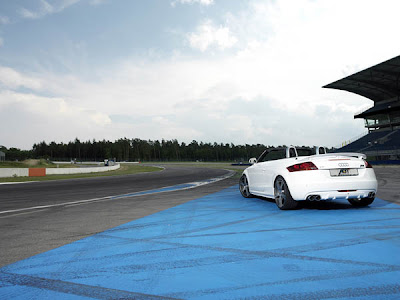

 An open roof sportscar in a tailor-made suit: The Abt TT Roadster
An open roof sportscar in a tailor-made suit: The Abt TT Roadster
Before the first preliminary designs were published, it was clear that the leading Audi tuner Abt Sportsline planned to cause a sensation with the new Audi TT, as the first TT is one of the favourite cars of the Kempten-based company with a long tradition. And this is due to the fact that the race version of the Sports Coupe 2002 won a lot of DTM (German Touring Car Series) races.
Therefore it is only logical that, after the extravagant TT-Sport and TT-R, also the TT Roadster, which is already exquisitely beautiful as serial car, gets a special treatment in the Allgaeu: the designer from Abt Sportsline developed car body parts with which the open-roof TT becomes more danymical. Thus, the front skirt with its grid element emphasizes the area around the fog lights and the single-frame grill. The brawny laterally attached parts underline the design of the convertible and create a unit with the striking rear section of the car. There the rear skirt inset and the rear wing, providing additional down force, are the central elements. Also the 4-pipe rear muffler, which perfectly harmonizes with the rear skirt inset and its integrated rear diffuser, belongs to the distinctive rear view of the Abt TT Roadster.
The Audi TT Roadster from Abt is an absolutely successful open-roof sportscar, a design masterpiece for ambitious pilots. Therefore, Abt Sportsline offers a number of power upgrade packages. The highlight of the product range is - similar to the Coupé - the TT-R with the VR6 3.2 K. The supercharger aggregate provides 355 hp (262 kW) and accelerates the car in about 5 sec. from standstill to 100 km/h. But also the other versions are extremely sporty. No matter if VR6 3.2 or 2.0 T-FSI engine, an Abt TT Roadster is always fast. For the favoured 2 liters Turbo FSI, Abt offers a power upgrade from 240 hp (177 kW) with special iS technology, sparing purse and environment, up to powerful 300 hp (221 kW). Matching to the always enormous propulsion of the Audi TT Roadster: Abt suspension kit. For more security in ticklish situations cares the Abt sports brake system with its huge disc diameters of 380x34 millimeters.
To perfectly round off the dynamical and powerful appearance of the Audi TT Roadster, Abt recommends the wheels AR 19 and SP1 in the size 19 inch, as well as the one inch bigger wheel AR20.
Labels: Audi





